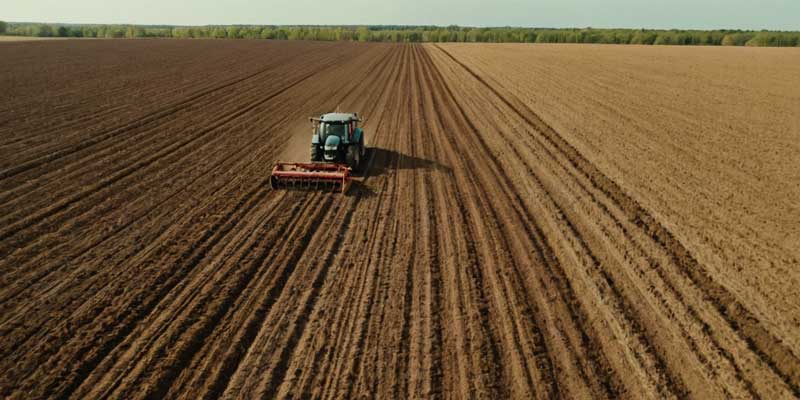Autonomous tractors, whether partially or fully automated, offer potential benefits beyond mere productivity, extending into safety, sustainability, and long-term success. Exploring the role and benefits of autonomous technologies in modern agriculture can shed light on how this emerging tool is helping farmers meet public demands for healthier agricultural practices while driving increased productivity and profits.

Introducing Autonomous Tractors
An autonomous tractor is a marvel of modern technology that combines facets of artificial intelligence, robotics, 360-degree vision cameras, and Global Positioning System (GPS) to guide agricultural operations.
A true autonomous tractor operates without human drivers, offering full autonomy in various agricultural tasks, from mowing to spraying. A variant of autonomy in tractors is Advanced Driver Assistance Systems (ADAS). This form of autonomy requires a person to remain in the driver’s seat while the tractor automatically manages part of the operation, such as staying centered on a row with an implement, allowing the operator to focus all their attention on implement operation. Many passenger vehicles on the roads today incorporate various ADAS functions, and you likely already use this technology routinely.
In agriculture, both variants of autonomy offer a promising future in how farmers can manage their operations. True autonomous tractors have the potential to transform not only large-scale production but also horticultural and even dairy farm practices, bringing a touch of Silicon Valley innovation to farms across America.
For years, traditional companies have focused on solutions for large-scale industrial farms. In a departure from this tradition, some companies, including some startups, are reimagining the tractor to provide solutions to smaller and medium-sized farms. In December 2022, Monarch Tractor, with its MK-V, introduced the world’s first fully electric tractor, with optional driver, connected, and true autonomous driving capabilities, which is expanding to meet demand. With this step, fruit and vegetable farms now have access to advantages that until now had only been available to much larger counterparts.
Autonomous tractors are not simply a response to labor shortages in agriculture; they are a forward-thinking solution that empowers farmers, driving long-term productivity, profitability, and sustainability on farms. Yes, autonomous tractors are high-tech, but in the case of the MK-V, they are also familiar, designed to seamlessly integrate with current agricultural equipment and operations to help agricultural work flow smoothly.
How do autonomous tractors work?
At the heart of any autonomous tractor, whether fully autonomous or ADAS, is a sophisticated blend of various cutting-edge technologies. Advances in areas like GPS, sensor technology, and 360° vision cameras harmoniously combine to create a robust autonomous operating system.
GPS
GPS forms the backbone of an autonomous tractor’s operation, providing precise, real-time location data. According to the Federal Aviation Administration, basic GPS service provides users with approximate accuracy of 7.0 meters, 95% of the time, anywhere on or near the Earth’s surface. It’s worth noting that the use of GPS, ADAS, and other technologies by Monarch Tractor allows the MK-V to operate with market-leading precision, enabling the tractor to navigate farmland efficiently and accurately.
Whether for tillage or row crop management, the GPS guidance system ensures that the autonomous tractor operates within defined parameters, minimizing overlaps and providing uniform coverage.
Sensor technology
Sensor technology incorporates the use of different types of sensors to detect key changes in the environment. This technology complements GPS, allowing the tractor to perceive its surroundings in real-time.
Commonly used in large tractors on industrial-sized farms, various types of sensor technology serve different functions. Sensors can provide critical data on a range of environmental parameters from soil conditions to plant health or weather conditions. Crop and soil health data can be accessed from any mobile device, providing farmers with real-time data and constant updates on health.
Other types of tractor sensors, such as those found in the MK-V, allow the tractor to monitor its own health, giving maintenance personnel a boost to keep the tractor in the field and out of the workshop. It’s important to recognize that the MK-V is an exception to the norm. The smart MK-V tractor belongs to a class of tractors that historically do not collect or communicate data sets. Fruit and vegetable farmers can now benefit from technological advantages that traditionally only industrial-sized farms have had access to.
360° Vision cameras
The autonomy stack of a tractor may include vision alongside GPS and AI, as is the case with Monarch’s MK-V. Visual information and real-time monitoring are features of Monarch’s Wingspan Ag Intelligence (WingspanAI), a fleet management and monitoring tool that gives operators a second pair of eyes to supervise the tractor remotely. The advanced tractor vision stack also captures live video images, turning them into actionable data, such as crop health monitoring, so farmers can address issues promptly. Along with GPS, the farmer knows exactly where a sick plant or a broken irrigation pipe is located
